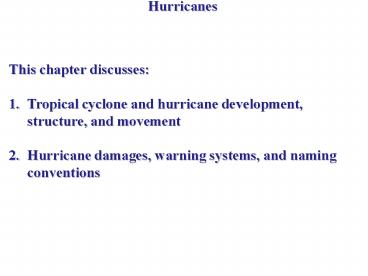Hurricanes - PowerPoint PPT Presentation
1 / 21
Title:
Hurricanes
Description:
... hurricanes, which typically form from an organized mass of storms formed along a tropical wave. ... less damaging storms, that do make landfall may not ... – PowerPoint PPT presentation
Number of Views:123
Avg rating:3.0/5.0
Title: Hurricanes
1
Hurricanes
- This chapter discusses
- Tropical cyclone and hurricane development,
structure, and movement - Hurricane damages, warning systems, and naming
conventions
2
Tropical Weather Waves
Tropical winds typically blow from the east, and
when they encounter a slow moving trough of low
pressure, called a tropical wave, the winds
initially converge and lift to produce showers
and thunderstorms.
Figure 16.1
3
Structure of a Hurricane
Tropical cyclones are the international name of
hurricanes, which typically form from an
organized mass of storms formed along a tropical
wave. In this image of Hurricane Elena, the
central area of broken clouds is the eye,
surrounded by an eye wall cloud and spiral rain
bands, with a total diameter nearing 500
kilometers.
Figure 16.2
4
Hurricane Wind Profile
Figure 16.3
The low pressure core of the hurricane is
surrounded by several thunderstorms, each with
updraft and downdraft cycles. The wind and
moisture cycle is repeated as surface moist air
converges in a counterclockwise pattern at the
eye, rises to create high pressure aloft,
condenses, precipitates, dries, diverges outward
in a clockwise pattern, sinks, and warms.
5
3-D Radar Image of Hurricane
Figure 16.4
Several key features of a hurricane are shown in
this radar composite image, including
overshooting clouds, the area of strongest echoes
(heaviest rain), and the eyewall.
6
Formation by Organized Convection
Figure 16.5A
One theory explains that hurricane formation
requires cold air above an organized mass of
thunderstorms, where the release of latent heat
warms the upper troposphere, creates high
pressure aloft, which pushes air outward and
causes a low to deepen at the surface. Air
moving toward this low intensifies the cycle.
7
Formation by Heat Engine
Another theory of hurricane development proposes
that a heat engine cycle, fueled by warm moist
input air and the release of heat when it
converts to cool dry air. Differences in the
input and output temperatures determine the
amount of work on the ocean and winds that is
performed.
8
Hurricane Stages of Development
The initial components of a hurricane may form as
a tropical disturbance, grow into a tropical
depression when winds exceed 20 knots, become a
tropical storm when winds exceed 35 knots, and
finally then qualify as a hurricane when winds
exceed 64 knots.
Figure 16.6
9
Hurricane Movement
Global patterns of tropical cyclone formation and
movement have been recorded on this figure, which
notes regional names for these systems. Travel
speeds for the hurricane my range from 10 to 50
knots, but they may also stall over a region and
cause destructive flooding.
Figure 16.7
10
Erratic Paths of Hurricanes
Figure 16.8
11
Historical charts of hurricane location may
reveal erratic, and hard to predict, patterns of
movement. As this figure shows, hurricanes may
occasionally double back. Further, when removed
from the ocean and without a moisture source to
supply energy, they may still continue an inland
journey. In the North Atlantic, on average 3
storms per year move inland and bring damaging
winds and rain.
12
North Atlantic Hurricanes
Composite infrared imagery of Hurricane Georges
reveals the pattern of a seasonal threat for
Central and North America coastlines. Tropical
cyclones at the same latitude survive longer in
the Atlantic than Pacific Ocean because of warmer
Atlantic Ocean waters.
Figure 16.9
13
Hurricane Damage Warning
Figure 16.11
Figure 16.10
Hurricanes have their highest wind speeds on the
side where storm pushing winds amplify cyclonic,
or counterclockwise, rotational winds. In coastal
areas, flooding is aggravated by the hurricane
low pressure triggering higher tides and Ekman
transport piling up water.
14
Hurricane Watch Warning
Figure 16.5A
The National Hurricane Center in Florida issues a
hurricane watch 24 to 48 hours before a
threatening storm arrives, and if it appears that
the storm will strike within 24 hours, a
hurricane warning is issued. While some consider
the warning area too large, causing unneeded
evacuation, such evacuations have saved many
lives. Hurricane Hugo, with peak winds near 174
knots, caused tremendous damage.
15
Hurricane Saffir-Simpson Winds
Figure 16.14
Figure 16.13A
In 1989 Hugo caused nearly 7 billion in damages
in the US, killing 49 in the Caribbean and US.
Current classification of hurricanes is based on
their wind speed, however, and not on human or
property damage. Hurricanes range from category
1 to 5, with winds of 64 to more than 135 knots.
16
Hurricane Saffir-Simpson Wind Damage-Potential
17
Hurricane Names and Cost
Category 5 Hurricane Andrew (1992) was the
costliest US storm, but it ranks as less intense
than 1935 and 1969 hurricanes. Hurricane names
are chosen from an alphabetical list of male and
female names for the Atlantic and Pacific, some
of which are retired if the storm was especially
damaging.
Figure 16.14
18
Hurricane Names for 2002-2005
19
Historical Hurricane Damage (Andrew reclassified
as 5)
20
Hurricane Andrew Devastation in Homestead,
Florida August 24, 1992
Figure 16.15
21
Likelihood for Landfall
Between 1900 and 1999, only three category 5
hurricanes have made landfall along the Gulf or
Atlantic. Numerous category 1, and less
damaging storms, that do make landfall may not
cause much damage, but bring needed rainfall.
Andrew makes this 3
Figure 16.16































